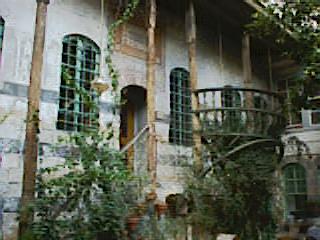 As we wandered beyond the confines of the souk in Old Damascus, we came
upon the Jabri house, a large Ottoman-style house with a large courtyard
that serves as a restaurant.
As we wandered beyond the confines of the souk in Old Damascus, we came
upon the Jabri house, a large Ottoman-style house with a large courtyard
that serves as a restaurant.
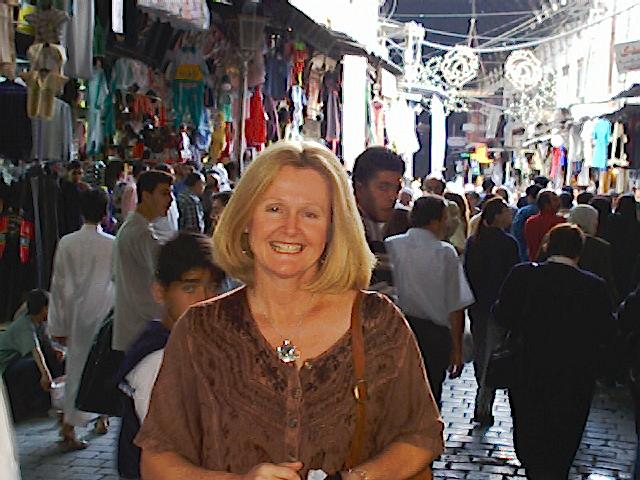 Our first stop was at the Hamadiyyah Souk, a covered bazaar that has about
anything in the world you would want, and all the merchants were willing
to offer us "special rates" on any purchase we wanted to make. If you can
take your eyes off the model in the foreground, you get some inkling of
the variety of goods as well as the number of people traversing these narrow
cobble stone streets. We looked for rugs, winter clothes, jewelry and a
good place to eat--well three out of four isn't bad!
Our first stop was at the Hamadiyyah Souk, a covered bazaar that has about
anything in the world you would want, and all the merchants were willing
to offer us "special rates" on any purchase we wanted to make. If you can
take your eyes off the model in the foreground, you get some inkling of
the variety of goods as well as the number of people traversing these narrow
cobble stone streets. We looked for rugs, winter clothes, jewelry and a
good place to eat--well three out of four isn't bad!
 As we wandered beyond the confines of the souk in Old Damascus, we came
upon the Jabri house, a large Ottoman-style house with a large courtyard
that serves as a restaurant.
As we wandered beyond the confines of the souk in Old Damascus, we came
upon the Jabri house, a large Ottoman-style house with a large courtyard
that serves as a restaurant.
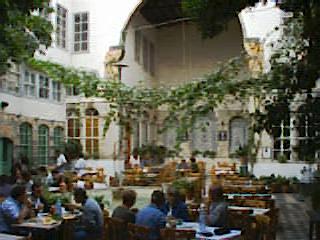 This
picture shows the size of the courtyard, as well as the enormous arch that
marks the entryway to the Jabri House. The atmosphere is enhanced by vines
that are growing on wires strung across the courtyard, as well as a large
fountain in its center
This
picture shows the size of the courtyard, as well as the enormous arch that
marks the entryway to the Jabri House. The atmosphere is enhanced by vines
that are growing on wires strung across the courtyard, as well as a large
fountain in its center
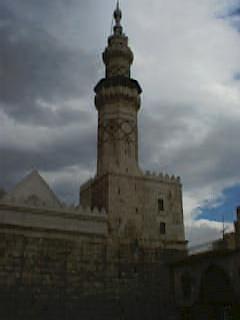 From the Jabri house, we wandered back towards the Omayyad Mosque, which
dates from the early days of Islam, when the Omayyad (or Umayyads) moved
the capital of Islam from Saudi Arabia to Damascus, where it was heavily
influenced by the Persian culture. This is a picture of the minaret, approaching
from the south. This overcast weather was only about the third cloudy day
in our two months in the Middle East.
From the Jabri house, we wandered back towards the Omayyad Mosque, which
dates from the early days of Islam, when the Omayyad (or Umayyads) moved
the capital of Islam from Saudi Arabia to Damascus, where it was heavily
influenced by the Persian culture. This is a picture of the minaret, approaching
from the south. This overcast weather was only about the third cloudy day
in our two months in the Middle East.
 Here is a picture of the courtyard inside the mosque. From the picture
you get a pretty good idea of the size of the courtyard as well as the
mosque itself. Worship takes place in the mosque proper, housed in the
wing just to the left of this picture.
Here is a picture of the courtyard inside the mosque. From the picture
you get a pretty good idea of the size of the courtyard as well as the
mosque itself. Worship takes place in the mosque proper, housed in the
wing just to the left of this picture.
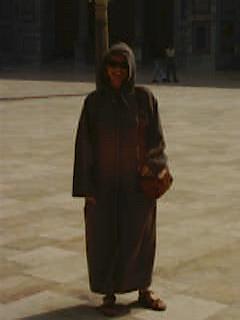 A
strangely familiar looking pilgrim . . . Actually, it's Tracy, modeling
the very fashionable clothing they provide western women visiting the mosque.
Quite fetching, the ensemble is equally at home on the runways of Milan
or the mosques of Syria!
A
strangely familiar looking pilgrim . . . Actually, it's Tracy, modeling
the very fashionable clothing they provide western women visiting the mosque.
Quite fetching, the ensemble is equally at home on the runways of Milan
or the mosques of Syria!
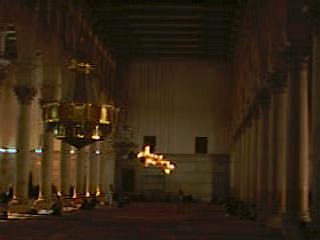 Here is a shot of the prayer hall of the mosque. To the left you can see
the worshippers facing the mihrab or the niche in the wall facing Mecca.
The entire space is open, except from the mihrab and minbar, shown below,
as well as several memorial to religious leaders. It is an open space,
covered with carpets, and illuminated by the large chandeliers shown in
the picture.
Here is a shot of the prayer hall of the mosque. To the left you can see
the worshippers facing the mihrab or the niche in the wall facing Mecca.
The entire space is open, except from the mihrab and minbar, shown below,
as well as several memorial to religious leaders. It is an open space,
covered with carpets, and illuminated by the large chandeliers shown in
the picture.
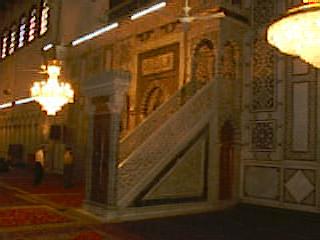 Finally, here is a picture of the "front" of the worship area. The large
structure in the center of the picture is the minbar, from which the imam
gives the Friday service. The entire front wall is lavishly decorated with
Arabic calligraphy and geometric designs (Islam forbids pictures or "graven
images). Just visible halfway up the minbar is the mihrab, or niche in
the wall that faces Mecca.
Finally, here is a picture of the "front" of the worship area. The large
structure in the center of the picture is the minbar, from which the imam
gives the Friday service. The entire front wall is lavishly decorated with
Arabic calligraphy and geometric designs (Islam forbids pictures or "graven
images). Just visible halfway up the minbar is the mihrab, or niche in
the wall that faces Mecca.
 Our last night we dined in Ottoman splendor at Elisar, a restaurant tucked
amid narrow windy streets at the eastern end of the Old City. The setting,
as you can see, was spectacular although, unfortunately, the food was not!
Our lack of enthusiasm for the food distressed the staff no end. As a result,
we were "treated" to an endless wave of bland dishes improperly prepared.
Our hopes of cutting our losses were replaced with a inexorable wave of
Middle Eastern hospitality, and many unpalatable courses later, we escaped!
While their culinary skills may be lacking, we found the Syrian people
to be warm, friendly and, above all, enthusiastic!
Our last night we dined in Ottoman splendor at Elisar, a restaurant tucked
amid narrow windy streets at the eastern end of the Old City. The setting,
as you can see, was spectacular although, unfortunately, the food was not!
Our lack of enthusiasm for the food distressed the staff no end. As a result,
we were "treated" to an endless wave of bland dishes improperly prepared.
Our hopes of cutting our losses were replaced with a inexorable wave of
Middle Eastern hospitality, and many unpalatable courses later, we escaped!
While their culinary skills may be lacking, we found the Syrian people
to be warm, friendly and, above all, enthusiastic!
Well, those are the highlights of our first real trip.
Please excuse the mini-history lesson: it's probably more than you ever
wanted to know about a mosque.